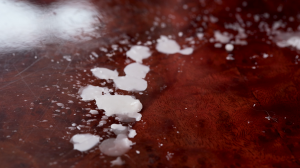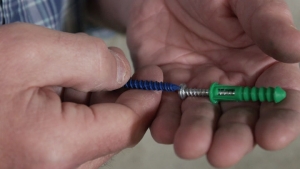How to Use a Fire Extinguisher Properly
View this quick video tip demonstrating how to use a fire extinguisher safely.
How to Use a Fire Extinguisher Properly
Knowing when and how to use a fire extinguisher can be crucially important. Make sure that everyone is on their way out of the house and the fire department has been called before you attempt to put out a fire with a fire extinguisher. Then, remember this word. Pass. P-A-S-S. P. Pull the pin. A. Aim at the base of the fire. S. Squeeze the trigger. Sweep back and forth, the second S, always leaving yourself a safe escape route. Be sure to check the gauge once a month to make sure that your fire extinguisher is full and if you have any questions about how to use this contact your fire department.
Be Prepared: Learn How to Use a Fire Extinguisher
A fire can start anytime, anywhere, and for any reason. It is always better to be safe than sorry. That's why it's important to know how to use a fire extinguisher in case of an emergency. A fire extinguisher is a device that can help you control small fires before they become big ones. In this blog post, we will discuss the different types of fire extinguishers, when and how to use them, and common mistakes people make when using them. We will also go over how to clean up the residue left behind after using a fire extinguisher. By the end of this post, you will have all the information you need to be prepared in case of a fire emergency.
What is a fire extinguisher?
A fire extinguisher is a tool that can be used to extinguish small fires. It contains a pressurized chemical agent and comes in different sizes and types for specific fires. Knowing how to use one is crucial before an emergency occurs.
How to use a fire extinguisher
In case of a fire emergency, one must know how to use a portable fire extinguisher properly. Begin by pulling out the safety pin from the handle while maintaining a safe distance from flames. Aim at the base of the flames with a nozzle and discharge dry chemical, foam, or water mist using sweep motion until the fires are out completely. Always remember to pick an appropriate extinguisher based on combustible materials involved in burning fires – Class A for ordinary materials like wood or paper, Class B for inflammable liquids, Class C for electrical equipment fires and Class K for cooking oils/grease fires in kitchens. In case things go awry despite attempts made through PASS method (Pull-Aim-Squeeze-Sweep), evacuate immediately via a clear exit or designated evacuation path & call the fire department/emergency services promptly.
Types of fire extinguishers
Portable fire extinguishers are vital components of any fire protection plan. Familiarity with the right type of fire extinguisher is essential to ensure safe evacuation in case of an emergency. A fire alarm system should always be activated before attempting to discharge an appropriate type of fire-extinguishing agent at a safe distance from the base of the flames. The acronym PASS method (pull the pin; aim the nozzle at the base of the fire; squeeze the lever slowly and evenly; sweep from side-to-side) is a useful guide for using a portable fire-extinguishing hose effectively. Don't forget to have an evacuation path cleared and easily accessible when dealing with grease fires or combustible metals.
Choosing the right fire extinguisher
When selecting a portable fire extinguisher, it's crucial to consider which type would be most appropriate based on the potential fire risks in your location. To determine the right type of fire extinguisher to use, it's essential to understand the five classes of fires: Class A (combustibles such as paper and wood), Class B (flammable liquids), Class C (electrical), Class D (combustible metals), and Class K (cooking oils and fats). Additionally, be mindful of choosing an appropriate nozzle and discharging agent to target the base of the flames effectively. Remember always to have clear exit routes, prioritize safety with proper training in handling an extinguisher, check your equipment regularly with fire drills, and evacuate immediately if necessary.
Common mistakes when using fire extinguishers
When using an extinguisher in case of a fire emergency situation avoid common mistakes such as choosing incorrect extinguisher type for different classes of fires and not knowing how to use it properly. Always aim low with the nozzle pointed at the base when discharging PASS acronym: Pull out the safety pin first before squeezing the lever then Sweep from side to side while keeping a safe distance. Remember regular practice with fire drills can prevent hazardous risks and guarantee safe evacuation paths. Clean up residue after use.
How to clean up residue after using a fire extinguisher
Properly cleaning up the residue after using an extinguisher is crucial for safety. Begin by wearing protective gear like gloves and a mask before removing any loose residue with a vacuum or broom. Use a damp cloth to wipe down surfaces and baking soda or specialized cleaner for stubborn spots. Disposing of contaminated materials safely is also essential. Remember to follow appropriate safety procedures while cleaning up the residue left behind.
Knowing how to use a fire extinguisher can mean the difference between a small fire and a devastating one. Remember to always choose the right type of extinguisher for the specific class of fire. Avoid common mistakes that people make when using fire extinguishers, such as not aiming at the base of the fire or not checking the pressure gauge beforehand. With these tips in mind, you’ll be better prepared in case of an emergency. Stay safe and be sure to share this guide with your loved ones so they can also learn how to properly use a fire extinguisher.
Blog Articles
Have You Heard of Landscape Glue?
You love the rustic charm of a gravel walkway, but the constant scattering of stones across your lawn and patio can be a real headache. Whether it’s from pets, lawn mowers, or just foot traffic, it seems impossible to keep those stones in place. Sound familiar? Well, Brian shows us a simple DIY method using landscape glue to keep your gravel path looking pristine and, more importantly, in place.
How to Remove Candle Wax Drips: Two Effective Methods
Candles create a warm and inviting atmosphere, but those pesky wax drips can be a real headache. Luckily, Brian shows us a couple of effective methods to tackle this issue, and they involve two very different temperatures: hot and cold. Here, we'll explore two effective methods: one using cold and the other using heat.
Guide to Hanging on Masonry Walls
Ever wondered how to hang that picture frame or shelf on a brick or concrete wall? It can seem daunting, but with the right tools and techniques, it's a straightforward DIY project. This guide breaks down two common methods: using concrete screws and using anchors, making it easy for you to tackle your next hanging project.





